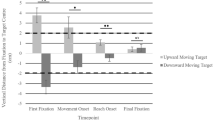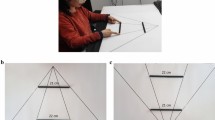Abstract
Our study examined the effects of performing a pointing movement with the left hand on the kinematics of a simultaneous grasping movement executed with the right hand. We were especially interested in the question of whether both movements can be controlled independently or whether interference effects occur. Since previous studies suggested that eye movements may play a crucial role in bimanual movement control, the effects of different fixation strategies were also studied. Human participants were either free to move their eyes (Experiment 1) or they had to fixate (Experiment 2) while doing the task. The results show that bimanual movement control differed fundamentally depending on the fixation condition: if free viewing was allowed, participants tended to perform the task sequentially, as reflected in grasping kinematics by a delayed grip opening and a poor adaptation of the grip to the object properties for the duration of the pointing movement. This behavior was accompanied by a serial fixation of the targets for the pointing and grasping movements. In contrast, when central fixation was required, both movements were performed fast and with no obvious interference effects. The results support the notion that bimanual movement control is moderated by fixation strategies. By default, participants seem to prefer a sequential behavior in which the eyes monitor what the hands are doing. However, when forced to fixate, they do surprisingly well in performing both movements in parallel.





Similar content being viewed by others
References
Adamovich SV, Berkinblit MB, Fookson O, Poizner H (1998) Pointing in 3D space to remembered targets. I. Kinesthetic versus visual target presentation. J Neurophysiol 79:2833–2846
Baldauf D, Deubel H (2008) Visual attention during the preparation of bimanual movements. Vision Res 48:549–563
Baldauf D, Wolf M, Deubel H (2006) Deployment of visual attention before sequences of goal-directed hand movements. Vision Res 46:4355–4374
Beggs WD, Howarth CI (1972) The accuracy of aiming at a target. Some further evidence for a theory of intermittent control. Acta Psychol 36:171–177
Berthier NE, Clifton RK, Gullapalli V, McCall DD, Robin DJ (1996) Visual information and object size in the control of reaching. J Mot Behav 28(3):187–197
Bingham GP, Hughes K, Mon-Williams M (2008) The coordination patterns observed when two hands reach-to-grasp separate objects. Exp Brain Res 184:283–293
Binkofski F, Dohle C, Posse S, Stephan KM, Hefter H, Seitz RJ, Freund HJ (1998) Human anterior intraparietal area subserves prehension—a combined lesion and functional MRI activation study. Neurology 50(5):1253–1259
Binsted G, Chua R, Helsen W, Elliott D (2001) Eye-hand coordination in goal-directed aiming. Hum Mov Sci 20:563–585
Biquer B, Jeannerod M, Prablanc C (1982) The coordination of eye, head, and arm movements during reaching at a single visual target. Exp Brain Res 46:301–304
Carlton L (1981) Processing visual feedback information for movement control. J Exp Psychol Hum Percept Perform 7(5):1019–1030
Castiello U, Bennett K (1997) The bilateral reach-to-grasp movement of Parkinson’s disease subjects. Brain 120:593–604
Castiello U, Bennett KMB, Stelmach GE (1993) The bilateral reach to grasp movement. Behav Brain Res 56:43–57
Chapman H, Gavrilescu M, Wang H, Kean M, Egan K, Castiello U (2002) Posterior parietal cortex control of reach-to-grasp movements in humans. Eur J Neurosci 15(4):2037–2042
Chua R, Elliott D (1993) Visual regulation of manual aiming. Hum Mov Sci 12:365–401
Corcos DM (1984) Two-handed movement control. Res Q Exerc Sport 55:117–122
Desmurget M, Jordan M, Prablanc C, Jeannerod M (1997) Constrained and unconstrained movements involve different control strategies. J Neurophysiol 77:1644–1650
Desmurget M, Epstein CM, Turner RS, Prablanc C, Alexander GE, Grafton ST (1999) Role of the posterior parietal cortex in updating reaching movements to a visual target. Nat Neurosci 2(6):563–567
Deubel H, Schneider WX (1996) Saccade target selection and object recognition: evidence for a common attentional mechanism. Vision Res 36:1827–1837
Deubel H, Schneider WX (2004) Attentional Selection in sequential manual movements, movements around an obstacle and in grasping. In: Humphreys GW, Riddoch MJ (eds) Attention in Action. Psychological Press, Hove, pp 69–91
Diedrichsen J, Nambisan R, Kennerley SW, Ivry RB (2004) Independent on-line control of the two hands during bimanual reaching. Eur J Neurosci 19:1643–1652
Elliott D, Roy EA, Goodman D, Carson RG, Chua R, Maraj BKV (1993) Asymmetries in the preparation and control of manual aiming movements. Can J Exp Psychol 47(3):570–589
Fowler B, Duck T, Mosher M, Mathieson B (1991) The coordination of bimanual aiming movements: evidence for progressive desynchronization. Q J Exp Psychol 43A(2):205–221
Glover S, Miall RC, Rushworth MF (2005) Parietal rTMS disrupts the initiation but not the execution of on-line adjustments to a perturbation of object size. J Cogn Neurosci 17(1):124–136
Goodale MA, Haffenden AM (1998) Frames of reference for perception and action in the human visual system. Neurosci Biobehav Rev 22:161–172
Grea H, Pisella L, Rossetti Y, Desumurget M, Tilikete C, Grafton S et al (2002) A lesion of the posterior parietal cortex disrupts on-line adjustments during aiming movements. Neuropsychologia 40:2471–2480
Hansen S, Glazebrook CM, Anson JG, Weeks DJ, Elliott D (2006) The influence of advance information about target location and visual feedback on movement planning and execution. Can J Exp Psychol 60(3):200–208
Hayhoe M, Ballard D (2005) Eye-movements in natural behavior. Trends Cogn Sci 9(4):188–193
Hesse C, Franz VH (2009) Memory mechanisms in grasping. Neuropsychologia 47(6):1532–1545
Heuer H, Klein W (2005) Intermanual interactions in discrete and periodic bimanual movements with same and different amplitudes. Exp Brain Res 167(2):220–237
Hick WE (1952) On the rate of gain of information. Q J Exp Psychol 4:11–26
Hyman R (1953) Stimulus information as a determinant of reaction time. J Exp Psychol 45:188–196
Jackson GM, Jackson SR, Kritikos A (1999) Attention for action: coordinating bimanual reach-to-grasp movements. Br J Psychol 90:247–270
Jakobson LS, Goodale MA (1991) Factors affecting higher-order movement planning: a kinematic analysis of human prehension. Exp Brain Res 86:199–208
Jeannerod M (1981) Intersegmental coordination during reaching at natural visual objects. In: Long J, Baddeley A (eds) Attention and Performance, vol 9. Erlbaum, Hillsdale, pp 153–168
Jeannerod M (1984) The timing of natural prehension movements. J Mot Behav 16(3):235–254
Jeannerod M (1999) Visuomotor channels: their integration in goal-directed prehension. Hum Mov Sci 18(2–3):201–218
Jeannerod M, Arbib MA, Rizzolatti G, Sakata H (1995) Grasping objects: the cortical mechanisms of visuomotor transformation. Trends Neurosci 18:314–320
Johansson RS, Westling GR, Backstrom A, Flanagan JR (2001) Eye-hand coordination in object manipulation. J Neurosci 21:6917–6932
Keele SW (1986) Motor control. In: Boff KR, Kaufman L, Thomas JP (eds) Handbook of perception and performance, vol 2. Wiley, New York, pp 30–60
Kelso JAS, Putnam CA, Goodman D (1983) On the space-time structure of human interlimb coordination. Q J Exp Psychol 35:347–375
Kelso JAS, Southard DL, Goodman D (1979a) On the coordination of two-handed movements. J Exp Psychol 5:229–238
Kelso JAS, Southard DL, Goodman D (1979b) On the nature of human interlimb coordination. Science 203:1029–1031
Land MF, Mennie N, Rusted J (1999) Eye movements and the roles of vision in activities of daily living: making a cup of tea. Perception 28(4):1311–1328
Marteniuk RG, MacKenzie CL, Baba DM (1984) Bimanual movement control: information procession and interaction effects. Q J Exp Psychol 36A(2):335–365
Medendorp WP, Crawford JD (2002) Visuospatial updating of reaching targets in near and far space. Neuroreport 13:633–636
Mieschke PE, Elliott D, Helsen WF, Carson RG, Coull JA (2001) Manual asymmetries in the preparation and control of goal-directed movements. Brain Cogn 45(1):129–140
Mountcastle VB, Lynch JC, Georgopoulos A, Sakata H, Acuna C (1975) Posterior parietal association cortex of the monkey: command functions of operations within extra-personal space. J Neurophysiol 38:871–908
Neggers SFW, Bekkering H (2000) Ocular gaze is anchored to the target of an ongoing pointing movement. J Neurophysiol 83:639–651
Neggers SFW, Bekkering H (2001) Gaze Anchoring to a pointing target is present during the entire pointing movement and is driven by a non-visual signal. J Neurophysiol 86:961–970
Paulignan Y, MacKenzie C, Marteniuk R, Jeannerod M (1991) Selective perturbation of visual input during prehension movements: 1. The effects of changing object position. Exp Brain Res 83:502–512
Peters M (1981) Attentional asymmetries during concurrent bimanual performance. Q J Exp Psychol 33A(1):95–103
Pisella L, Grea H, Tilikete C, Vighetto A, Desmurget M, Rode G et al (2000) An ‘automatic pilot’ for the hand in human posterior parietal cortex: toward reinterpreting optic ataxia. Nat Neurosci 3(7):729–736
Riek S, Tresilian JR, Mon-Williams M, Coppard VL, Carson RG (2003) Bimanual aiming and covert attention: one law tow hands. Exp Brain Res 153:59–75
Schettino LF, Adamovich SV, Poizner H (2003) Effects of object shape and visual feedback on hand configuration during grasping. Exp Brain Res 151(2):158–166
Schiegg A, Deubel H, Schneider WX (2003) Attentional selection during preparation of prehension movements. Vis Cogn 10(4):409–431
Schlicht EJ, Schrater PR (2007) Effects of visual uncertainty on grasping movements. Exp Brain Res 182:47–57
Serrien DJ, Strens LHA, Oliviero A, Brown P (2002) Repetitive transcranial magnetic stimulation of the supplementary motor area (SMA) degrades bimanual movement control in humans. Neurosci Lett 328:89–92
Shima K, Tanji J (1998) Both supplementary and presupplementary motor areas are crucial for the temporal organization of multiple movements. J Neurophysiol 80:3247–3260
Smeets JBJ, Brenner E (1999) A new view on grasping. Mot Control 3:237–271
Spijkers W, Heuer H, Kleinsorge T, van der Loo H (1997) Preparation of bimanual movements with same and different amplitudes: specification interference as revealed by reaction time. Acta Psychol 96:207–227
Spijkers W, Tachmatzidis K, Debus G, Fischer M, Kausche I (1994) Temporal coordination of alternative and simultaneous aiming movements of constrained timing structure. Psychol Res 57:20–29
Swinnen SP, Jardin K, Meulenbroek R (1996) Between-limb asynchronies during bimanual coordination: effects of manual dominance and attentional cuing. Neuropsychologia 34(12):1203–1213
Wing AM, Turton A, Fraser C (1986) Grasp size and accuracy of approach in reaching. J Mot Behav 18:245–260
Winges SA, Weber DJ, Santello M (2003) The role of vision on hand preshaping during reach to grasp. Exp Brain Res 152(4):489–498
Acknowledgments
This study was supported by the Cluster of Excellence “Cognition for Technical Systems” (Project 301) and by the 7th Framework Program of the European Community (project “GRASP”, ICT-215821). We also thank Paul Taylor for helpful comments on the manuscript.
Author information
Authors and Affiliations
Corresponding author
Rights and permissions
About this article
Cite this article
Hesse, C., Nakagawa, T.T. & Deubel, H. Bimanual movement control is moderated by fixation strategies. Exp Brain Res 202, 837–850 (2010). https://doi.org/10.1007/s00221-010-2189-3
Received:
Accepted:
Published:
Issue Date:
DOI: https://doi.org/10.1007/s00221-010-2189-3




